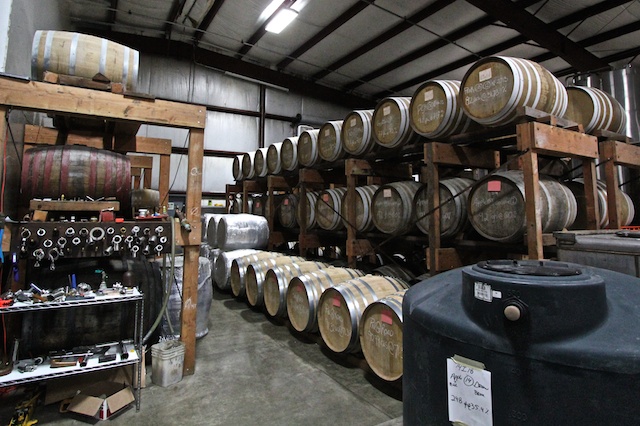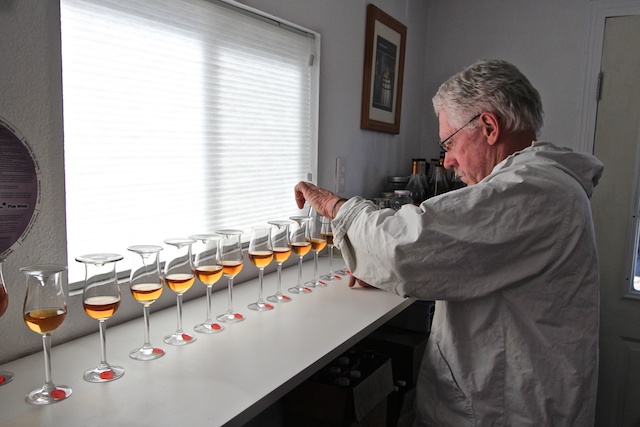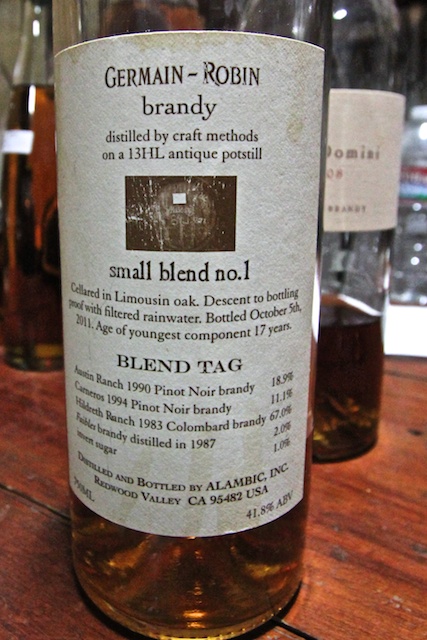California Pioneers – Part II

When you look at the Germain Robin warehouse—the barrels racked on top of one another like any standard operation—it doesn't seem like a vast inventory of more than 1500 casks. It's an impressive sight, but it doesn't look like thousands of barrels. Nevertheless, that's what Ansley and company are sitting on: a veritable treasure trove of old stock that is as extensive as any large producer in America (despite the fact that Germain Robin is tiny). The situation is not unfamiliar, nor is it unprecedented. For years, both Scottish and American whiskey producers found themselves in similar shoes; tons of aging backstock due to slumping sales and lack of consumer interest. Despite the indisputable quality of the Germain Robin brandies, let's not kid ourselves here—brandy isn't, and hasn't been, a popular player in the new spirits market. Those who do distill brandy are definitely making more than they're selling, unlike whisky distillers who currently have the opposite problem.
As a consumer, however, this is exactly when you want to buy in: when the market isn't hot. All those stories you hear about "the good old days" of whisky drinking; buying as much Pappy as you wanted right off the shelf—those days are right now for brandy drinkers. There's never been a better supply of great Armagnac and Cognac at K&L, with 35 and 40 year old expressions hovering around the $120 mark. Germain Robin, however, is on another level when it comes to brandy production. They're using much higher-quality grapes, making base wines that are actually drinkable, and they're not dumping in boise to cover any mistakes or rough edges. They are as pure and polished as brandy gets. Dan Berger of the LA Times famously wrote: "No Cognac is as good as Germain Robin." I wouldn't argue with that statement, but I'd probably offer my own retort: "No Cognac is as dynamic, versatile, or as interesting as Germain Robin." Not only is there no Cognac distiller in France making grape distillates on the level of Germain Robin, there's no Cognac distiller in France coming even close. The boys up in Ukiah aren't even looking across the Atlantic anymore; they're on an entirely new level.

Tasting simply the Germain Robin Craft Method or the Coast Road expression may not convince you of greatness. "There are many Cognacs out there finer than either of those California brandies," one might argue. This is true. The Craft Method and Coast Road are the VS and VSOP of the Germain Robin portfolio, with the XO being—obviously—the XO. There are numerous Cognacs in stock at K&L that I believe outshine the entry level expressions from Germain Robin, although they're much older. Personally, I'd stack the XO from Germain Robin against any competitor from Cognac, any day of the week. Dollar for Dollar, you won't beat it. Distilled pinot noir wine simply adds another dimension to the blend that ugni blanc isn't capable of. Distilling pinot noir has taken Germain Robin up a notch in the hierarchy of great brandies. Ansley Coale, who you can see above readying samples for my visit yesterday, is now getting ready to raise the ante even higher. He's willing to bet that the new Germain Robin ultra-mature and ultra-rare editions are better than any Cognac, at any age, from any producer—period; and his new portfolio of limited expressions will hopefully prove that point.
And so I made the trip to sample these new (old) expressions and see if they were everything I hoped they would be. Let's take a look at what's coming later this month from Germain Robin:
Germain Robin 30 Year Old $500 - Whereas a number of the other ancient releases will be limited, one-time-only expressions, the 30 year will be a continual 200 bottle per year allocation. The base of the spirit is 1983 distilled pinot noir and a bit of Colombard from 1984; that's about it. It's proofed down to 42% (naturally for the most part) and is entirely unfiltered. The first thing you notice as you take a sip is that the fruit is still the focus. Despite 30+ years in wood, these brandies have maintained their core acidity; almost like you would expect from a 1982 Lafite, or DRC Burgundy. There's oak, but this brandy isn't about the wood; it's about the interconnection between oak maturation and the inherent quality of the spirit. I was blown away immediately just from that realization. There's not much of this stuff either; just a few barrels from each year to pull from. The grace of the palate is tremendous. It's still youthful; there's vigor and life. A vinous character comes through first, before a seamless transition into spice and oak takes over on the finish. There's no caramel flavor though; not a drop—unlike you would find in the Cognac counterparts, where the boise dominates the backend. That dry spice finish goes on for minutes. It's so elegant. Hubert's mantra was always: alcohol is there to carry the flavor; if you don't notice it then the brandy is perfect. I'd say this is a perfect brandy by that standard. Spellbinding.
Germain Robin Barrel #351 $600 - 1987 is considered by Ansley and Hubert to be the best vintage for both the fruit and the distillates in the Germain Robin archive. Everything went right that year; both the weather and the distillation process. 120 bottles were filled from this single cask of 1987 Welch Vineyard pinot noir distillate, made from grapes taken purely from the Potter Valley site. It's as close as a spirit can get to expressing vintage and terroir. The first sip reveals a fatter, more supple mouthfeel than the 30 year. The vinous character of the pinot noir coats the palate with more richness, giving more of an assertive Armagnac character. Despite that initial rush, the finish is extremely delicate and focused; possibly due to the higher elevation and higher acidity of that pinot noir. It's lazer-like at the end—a beam of soft fruit, round oak, and baking spices that still brings acidity, rather than creamy caramel or dessert-like sweetness. I can't stress enough how much more refined these brandies are in that they do not rely on richness or oak. They contain both elements, but only to balance out the equation. Like fine wines, it's mostly about the quality of the fruit and the skill of the process; too much vanilla and oak means you didn't have good fruit, or you don't know what you're doing. Another big winner.
Germain Robin Augustin's Blend $700 - This is a mystery blend composed by Hubert for Ansley's son (Augustin), put aside for the future in the timeless tradition of Cognac. Hubert would also put special blends aside for his children, as was once done for him. At this point, however, neither Ansley or Hubert remember what exactly was in the blend because it was done off the books for personal use, rather than documented as part of Germain Robin's archive. The only information that is known pertains to the vintages: 1987 & 1988. There are only 60 bottles left in the barrel for public purchase. This brandy is amazing right off the bat. Soft, supple fruit, dainty vanilla and oak spices, then a creaminess that becomes almost ghostly as it slowly fades into a specter of what it once promised. That's not a criticism, though; it's a beautiful anomaly. It's a faint whisper of elegance that really gives you a sense of how special these brandies are. They're delicate by design. A touching tribute to Ansley's son who for some reason is allowing dad to sell the rest of his inheritance! (Augustin—between me and you, I hope you squirreled away some of this for later. It's outrageously good).
Germain Robin Anno Domini $400 - Previously released in other incarnations, the Anno Domini is a solera-style blend that dates back to 1983 and runs into the late 90s; so you're talking a marriage of spirits from 30 years of age to about 15+. The selling point of the Anno Domini, however, is that the blend contains a bit of brandy distilled from dry-farmed Palomino from the late 80s—perhaps the rarest and most treasured gem in the library. The Anno Domini is the type of thing you break out after a fancy dinner. It's a crowd-pleaser on the highest level. Much more intense richness, underlined by a backbone of oak spice and the acidity from the pinot noir. It's the whole show, from beginning to end. Big, undulating waves of pinot noir fruit that come over the palate like a pulsing beat of goodness.

Germain Robin Small Blend #1 $290 - I had to include a photo of the upcoming label for Small Blend #1 because it's exactly what geeky guys like myself want on a package: a clean, classy breakdown of what's inside; with percentages, no less!! Look at what you're dealing with here: 1990 Austin's Ranch pinot noir, 1994 Carneros pinot noir (riper and juicier, for those of you who don't drink pinot), 1983 Hildereth Ranch Colombard (not easy to find in California back then), and some Faibles brandy distilled in 1987 (which I learned is older brandy that has gone underproof, used like a boise to sweeten up a blend). This is the type of brandy you pour for someone—even someone who doesn't normally drink brandy—and they say, "WOW!" It's immediately impressive, from the cinnamon red hot spice coming via the oak, to the balance and seamless way these four brandies work together; strengthening each other and filling out any potential flaws. Love it. LOVE it. Only 220 bottles will be released.
Germain Robin Small Blend #2 $300 - I was really looking forward to this one, just based on the specs. 39.8 % 1984 California Gamay Beaujolias (Oh my God!) with 35.2% 1989 Colombard and 25% 1994 pinot noir. A bit higher in proof at 44.5%, that extra lift is apparent on the initial sip. The red-fruited juiciness of the gamay is actually palpable and takes center stage, forcing the other two brandies to supporting roles. The warmth and spice from the Colombard picks up on the mid-palate and the acidity and focus from the pinot noir balances out the backend. It's explosive on the finish though; both sweet and savory. Fun, fun, fun.
Germain Robin Small Blend #3 $285 - This is the smallest of the three blends and also has its own vintage of 1985 distilled gamay, along with 1996 Roederer pinot noir, two 1997 Colombard distillates, and a blend of 1996 muscat, viognier, and riesling. The wine geek in me just shot my load. This is wildly different than the other two blends, more muted and less spicy with the aromatic varietal brandy really coming through. Muscat distillates have a distinct floral and perfumy character (as we recently tasted with the unaged Singani 63) and that's a big part of the backbone for this blend. It's awesome, as that hint of white flowers mixes perfectly with the softness of the Colombard and the supple weight from the pinot noir. This might be my favorite one so far. Just awesome in every way.
There are more old and rare Germain Robin brandies to come besides the few listed above, but they're mostly expanded versions of expressions previously released. There are four new single barrels (including an incredible muscat and a dreamy semillon) as well as a new batch of Old Havana and some Apple XO. I did get a chance to taste these releases as well and I found them all to be exceptional. They're fantastic, but they're not on the level of the brandies above. The seven expressions I've covered so far are not to be missed, even at the high prices being asked. If you think they're too esoteric to sell at those costs, let me share this with you: I've already pre-sold more than 80 bottles just from collectors calling to inquire. They knew about these brandies before I did and they were salivating at the chance to get a bottle or two (or ten). The only reason I haven't already sold more is because Germain Robin has to allocate these bottles fairly amongst all their customers nationwide. When I say this is a big deal, I mean it. K&L might not get much more than the amount I've already promised to some of my best customers.
And, let me tell you, they're worth the cash. Not only is each bottle spectacularly crafted and distilled from fruit of the highest quality with the maximum level of care, they are pieces of California history. These are the oldest American spirits currently available in the United States, and they represent the efforts of two pioneers who let their passion for perfection guide them on one hell of an adventure. The fact that we get to taste these expressions—that they're even making some of these brandies available to the public—is incredible. I'm looking forward to buying one or two of my own.
I can't say this enough: this is a big deal, folks. I hope those who do splurge for a bottle understand exactly what they're drinking. Hopefully this blog will help!
-David Driscoll
